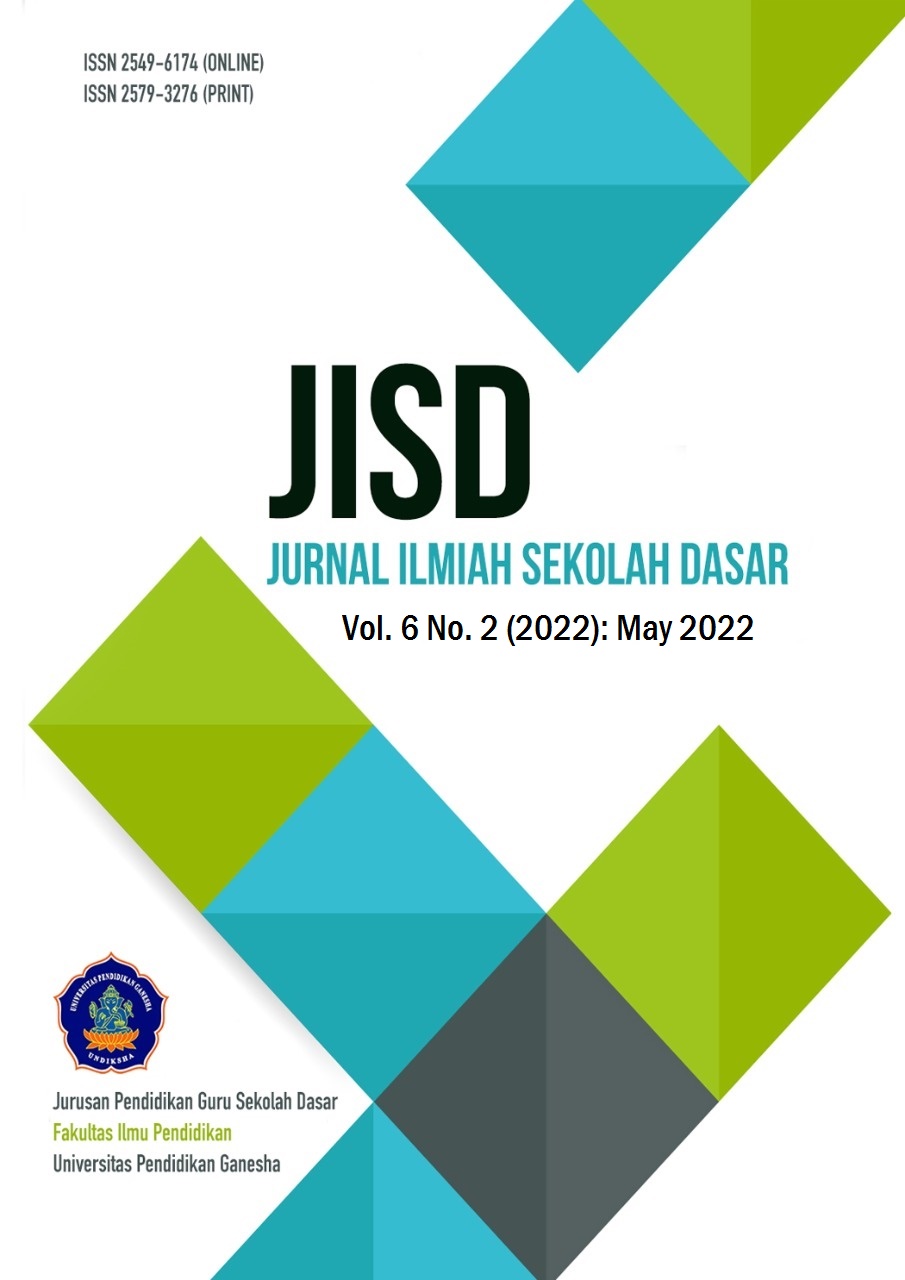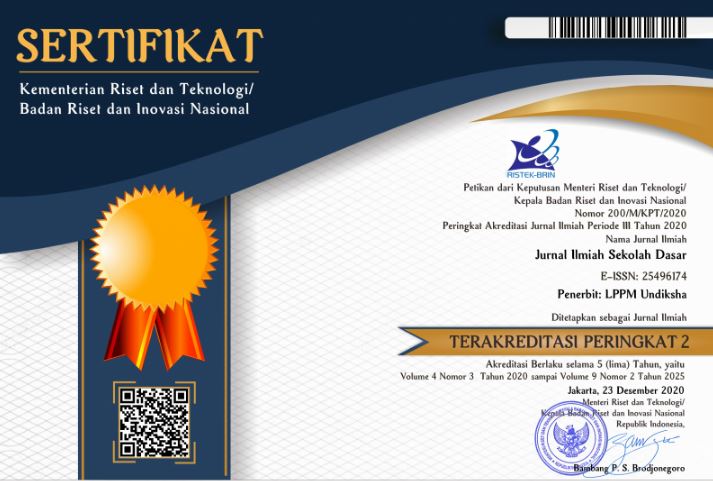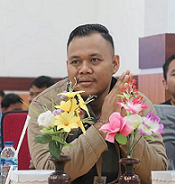Implementation of Wayang Sukuraga to Improve the Social Attitudes of Elementary School Students
DOI:
https://doi.org/10.23887/jisd.v6i2.43710Keywords:
social attitudes, Sukuraga puppets, action researchAbstract
Wayang, as one of the traditional arts, is also a work of art that functions as a means of entertainment, education, and social media. This study aims to analyze the improvement of students' social attitudes in fifth-grade elementary school through the wayang sukuraga. This research design is a Classroom Action Research developed by Kemmis and Mc. Taggart with the implementation of research as much as 2 cycles. Subjects in this study amounted to 23 people. Data collection techniques were carried out using non-test techniques consisting of interviews, teacher activity observation sheets, student social attitudes observation sheets, field notes, and documentation of research activities. The data analysis technique was carried out descriptively. The results showed that the activities of educators in the first cycle obtained an average of 74 in the good category. In contrast, in the second cycle, they obtained an average of 88 in the good category. As for the social attitudes of students in the first cycle, the average result was 70% through the application of the puppet sukuraga in the fairly good category and then increased to 86% with the good category in the second cycle. Based on the results obtained, it can be concluded that the wayang sukuraga can improve the social attitudes of students in elementary schools.
References
Abdurrohim, M., Tryanasari, D., & Hartini. (2020). Pengembangan E-Comic Berbasis Wayang Materi Perubahan Bentuk Energi dan Sumber Energi Alternatif Untuk Kelas IV SD. Pancar (Pendidikan Anak Cerdas Pintar), 4(2), 53–65. https://doi.org/10.52802/pancar.v4i2.4.
Abu Nasra, M., & Arar, K. (2020). Leadership style and teacher performance: mediating role of occupational perception. International Journal of Educational Management, 34(1), 186–202. https://doi.org/10.1108/IJEM-04-2019-0146. DOI: https://doi.org/10.1108/IJEM-04-2019-0146
Adawiyah, R., Isnaini, N. F., Hasanah, U., & Faridah, N. R. (2021). Kesiapan Pelaksanaan Pembelajaran Tatap Muka pada Era New Normal di MI At-Tanwir Bojonegoro. Jurnal Basicedu, 5(5), 3814–3821. https://doi.org/10.31004/basicedu.v5i5.1435. DOI: https://doi.org/10.31004/basicedu.v5i5.1435
Amirono, M. T., & Daryanto. (2016). Evaluasi dan Penilaian Pembelajaran Kurikulum 2013. Gaya Media.
Asyifa, B. F., Rudyatmi, E., & Abdullah, M. (2019). The Development of Plant Encyclopedia Based on Datebase in Adiwiyata Senior High School. Unnes Journal of Biology Education, 8(1). https://doi.org/10.15294/jbe.v8i1.26526. DOI: https://doi.org/10.15294/jbe.v8i1.26526
Ataman, K., Bozkurt, V., Göka, E., İLHAN, M. N., YILDIRIM, N., Çiftçi, E., Liman, U., & Vuran, B. (2021). The social effects of COVID-19 pandemic. Turkish Bulletin of Hygiene and Experimental Biology, 78(3). DOI: https://doi.org/10.5505/TurkHijyen.2021.83357
Bahadori, A., & Afrooz, G. (2018). Effectiveness of puppet therapy interventions in social efficacy of children with high-performance autism. Asian Journal of Research in Social Sciences and Humanities, 8(7). https://doi.org/10.5958/2249-7315.2018.00112.0. DOI: https://doi.org/10.5958/2249-7315.2018.00112.0
Banshchikova, T., Solomonov, V., & Fomina, E. (2015). Attitudes and Tolerance in the Structure of Individual Readiness for Intercultural Interaction. Procedia - Social and Behavioral Sciences, 214. https://doi.org/10.1016/j.sbspro.2015.11.753. DOI: https://doi.org/10.1016/j.sbspro.2015.11.753
Bustami, Y., Corebima, A. D., Suarsini, E., & Ibrohim. (2017). The social attitude empowerment of biology students: Implementation JiRQA learning strategy in different ethnics. International Journal of Instruction, 10(3), 15–30. https://doi.org/10.12973/iji.2017.1032a. DOI: https://doi.org/10.12973/iji.2017.1032a
Dessiane, S. T., & Kristin, F. (2021). Pengembangan Instrumen Penilaian Sikap Sosialpembelajaran Tematik Kelas 4 SD. Jurnal Pendidikan Ilmu Pengetahuan Sosial Indonesia, 6(1), 21–26. https://doi.org/10.26737/jpipsi.v6i1.2310.
Dewi, M. R. S., Murda, I. N., & Pudjawan, K. (2019). Pengaruh Model Pembelajaran Somatic Auditori Visual Intelektual (SAVI) Terhadap keterampilan Berpikir Kritis IPS Siswa Kelas V di Gugus III Kecamatan Gianyar Kabupaten Gianyar Tahun Pelajaran 2017/2018. Mimbar PGSD Undiksha, 7(1). https://doi.org/10.23887/jjpgsd.v7i1.17022.
Ferguson, S. K. (2021). Affective education: Addressing the social and emotional needs of gifted students in the classroom. In Methods and materials for teaching the gifted. DOI: https://doi.org/10.4324/9781003236603-19
Hossain, A., & Tarmizi, R. A. (2013). Effects of Cooperative Learning on Students’ Achievement and Attitudes in Secondary Mathematics. Procedia - Social and Behavioral Sciences, 93, 473–477. https://doi.org/10.1016/j.sbspro.2013.09.222. DOI: https://doi.org/10.1016/j.sbspro.2013.09.222
Juliana, A. D., Nurasiah, I., & Wardana, A. E. (2019). Peningkatan Keterampilan Bercerita Melalui Media Wayang Sukuraga Berbasis 5 Karakter DI Kelas Tinggi. Attadib Journal Of Elementary Education, 3(2). https://doi.org/10.32507/attadib.v3i2.500.
Kasman, K., & Hamdani, Z. (2021). The Effect of Zoom App Towards Students’ Interest in Learning on Online Learning. Dinasti International Journal of Education Management And Social Science, 2(3), 404–408. https://doi.org/10.31933/dijemss.v2i3.752. DOI: https://doi.org/10.31933/dijemss.v2i3.752
Kemmis, S., & Taggart. (1988). The Action Research Planner.
Kuntoro, B. T., & Wardani, N. (2020). Pengembangan Instrumen Penilaian Sikap Sosial Pembelajaran Tematik Kelas III SD. Jurnal Ilmiah Wahana Pendidikan, 6(2). https://doi.org/10.5281/zenodo.3752471.
Lailiyah, & Wulansari. (2017). Peningkatan Keterampilan Berbicara Melalui Metode Diskusi Kelompok Model Tanam Paksa Siswa Kelas X Pemasaran 1 SMK PGRI 2 Kediri. JP (Jurnal Pendidikan), 1(2), 166–173. https://doi.org/10.26740/jp.v1n2.p166-173. DOI: https://doi.org/10.26740/jp.v1n2.p166-173
Lyesmaya, D., Sutisnawati, A., Hamdani, L., Wardana, A., Nurasiah, I., Uswatun, D., & Amalia, A. (2019). Integrity Value in Local Wisdom (Wayang Sukuraga): Character Education Media Learning in Elementary School. EUDL. https://doi.org/10.4108/eai.29-8-2019.2289146. DOI: https://doi.org/10.4108/eai.29-8-2019.2289146
Manzano-Sánchez, D., & Valero-Valenzuela, A. (2019). Implementation of a model-based programme to promote personal and social responsibility and its effects on motivation, prosocial behaviours, violence and classroom climate in primary and secondary education. International Journal of Environmental Research and Public Health, 16(21). https://doi.org/10.3390/ijerph16214259. DOI: https://doi.org/10.3390/ijerph16214259
Masrom, M. B., Busalim, A. H., Abuhassna, H., & Mahmood, N. H. N. (2021). Understanding students’ behavior in online social networks: a systematic literature review. In International Journal of Educational Technology in Higher Education. https://doi.org/10.1186/s41239-021-00240-7. DOI: https://doi.org/10.1186/s41239-021-00240-7
Maulida, I., Dibia, I. K., & Astawan, I. G. (2020). The Development of Social Attitude Assessment Instrument and Social Studies Learning Outcomes Grade IV on Theme of Indahnya Keragaman di Negeriku. Indonesian Journal Of Educational Research and Review, 3(1), 12. https://doi.org/10.23887/ijerr.v3i2.25823. DOI: https://doi.org/10.23887/ijerr.v3i2.25823
Mega, C., Pudjawan, K., & Margunayasa, I. G. (2015). Analisis sikap sosial siswa kelas V pada pembelajaran dengan kurikulum 2013. Mimbar PGSD Universitas Pendidikan Ganesha, 3(1). https://doi.org/10.23887/jjpgsd.v3i1.5631.
Miskawati, M. (2019). Upaya Meningkatkan Kreativitas Anak Dalam Pembelajaran Seni Tari Melalui Strategi Belajar Sambil Bermain di TK Islam Sa’adatul Khidmah Tahun Pelajaran 2016/2017. Jurnal Ilmiah Dikdaya, 9(1), 45. https://doi.org/10.33087/dikdaya.v9i1.123. DOI: https://doi.org/10.33087/dikdaya.v9i1.123
Nissa, S. F., & Haryanto, A. (2020). Implementasi Pembelajaran Tatap Muka Di Masa Pandemi Covid-19. Jurnal IKA PGSD (Ikatan Alumni PGSD) UNARS, 8(2), 402. https://doi.org/10.36841/pgsdunars.v8i2.840. DOI: https://doi.org/10.36841/pgsdunars.v8i2.840
Putriani, N. E., Marwati, S., & Mudra, I. W. (2018). Interpreting the Tri Mandala Concept on the Motif of Gringsing Wayang Kebo Woven Cloth. Lekesan, 1(1). https://doi.org/10.31091/lekesan.v1i1.343. DOI: https://doi.org/10.31091/lekesan.v1i1.343
Rahma, N. A., & Pujiastuti, H. (2021). Efektivitas Pembelajaran Daring Matematika Pada Masa Pandemi Covid-19 Di Kota Cilegon [the Effectiveness of Mathematics Online Learning During the Covid-19 Pandemic in Cilegon City]. JOHME: Journal of Holistic Mathematics Education, 5(1), 1. https://doi.org/10.19166/johme.v5i1.3811. DOI: https://doi.org/10.19166/johme.v5i1.3811
Rahman, M. (2019). Secondary School Students Attitude Towards Junior School Certificate (Jsc) Examination In Bangladesh. International Journal of Education, 11(2), 158–168. https://doi.org/10.17509/ije.v11i2.14746. DOI: https://doi.org/10.17509/ije.v11i2.14746
Reffiane, F., & Mazidati, I. (2016). Implementasi Pengembangan Media Wayang Kerton Pada Tema Kegiatan Sehari-Hari. Jurnal Mimbar Sekolah Dasar, 3(2). https://doi.org/10.53400/mimbar-sd.v3i2.4256. DOI: https://doi.org/10.17509/mimbar-sd.v2i1.1323
Rochimatun, S. (2016). Optimalisasi Penerapan Metode Diskusi Kelompok Untuk Meningkatkan Hasil Belajar Ekonomi Dengan Materi Pokok Ekonomi dan Sistem Ekonomi Pada Siswa Kelas X.3 Semester Satu SMA Negeri 3 Sukoharjo Tahun Pelajaran 2014/2015. Jurnal Pendidikan Ilmu Sosial, 26(2), 12–23. https://doi.org/10.21831/pg.v11i2.10659. DOI: https://doi.org/10.21831/pg.v11i2.10659
Rosnaeni, Muslimin, & Saehana, S. (2018). Perbandingan Keterampilan Proses Sains antara Kelompok Siswa yang Diajar dengan Model POE dan Model Discovery. Jurnal Pendidikan Fisika, VI(1), 43–53. https://doi.org/10.24127/jpf.v6i1.1260.
Rusmiati, R., & Nugroho, A. S. (2019). Pengaruh Model Pembelajaran TGT dengan Media Pop Up Terhadap Hasil Belajar Kelas IV Tema 6 Cita-Citaku Subtema 3. Jurnal Pedagogi Dan Pembelajaran, 2(2), 241. https://doi.org/10.23887/jp2.v2i2.17914. DOI: https://doi.org/10.23887/jp2.v2i2.17914
Salame, I. I., & Nazir, S. (2019). The Impact of Supplemental Instruction on the Performance and Attitudes of General Chemistry Students. International Journal of Chemistry Education Research. https://doi.org/10.20885/ijcer.vol3.iss2.art1. DOI: https://doi.org/10.20885/ijcer.vol3.iss2.art1
Sibarani, C. (2019). Students Perceptions of Teachers Use of Bahasa Indonesia in the English Classroom. JET (Journal of English Teaching), 5(3), 217. https://doi.org/10.33541/jet.v5i3.1315. DOI: https://doi.org/10.33541/jet.v5i3.1315
Siri, A., Supartha, I. W. G., Sukaatmadja, I. P. G., & Rahyuda, A. G. (2020). Does Teacher Competence and Commitment Improve Teacher’s Professionalism. Cogent Business & Management, 7(1), 1781993. https://doi.org/10.1080/23311975.2020.1781993. DOI: https://doi.org/10.1080/23311975.2020.1781993
Soleh, & Zainiyati, H. S. (2020). Does Motivation, Personality and Environment Influence Enthusiasm of Generation Z to Contuining Study to Higher Education? International Journal of Educational Research Review, 287–295. https://doi.org/10.24331/ijere.748771. DOI: https://doi.org/10.24331/ijere.748771
Sunardi, dan S. N. dan K. (2016). Pertunjukan Wayang Babad Nusantara : Wahana Pengajaran Nilai Kebangsaan Bagi Generasi Muda. Jurnal Seni Dan Budaya, 26(2), 195–207. https://doi.org/10.26742/panggung.v26i2.176. DOI: https://doi.org/10.26742/panggung.v26i2.176
Syawaludin, A., Gunarhadi, & Rintayati, P. (2019). Enhancing elementary school students’ abstract reasoning in science learning through augmented reality-based interactive multimedia. Jurnal Pendidikan IPA Indonesia, 8(2), 288–297. https://doi.org/10.15294/jpii.v8i2.19249. DOI: https://doi.org/10.15294/jpii.v8i2.19249
Utami, Purnomo, & Salam. (2018). Penanaman Sikap Sosial Melalui Pembelajaran Ips Pada Siswa Smp Islam Sudirman Ambarawa Kabupaten Semarang. Sosiolum, 1(1), 40–52. https://doi.org/10.15294/sosiolium.v1i1.30446. DOI: https://doi.org/10.15294/sosiolium.v1i1.30446
Virani, Riastini, & Suarjana. (2016). Deskripsi Sikap Sosial Siswa Kelas Iv Sd Negeri 4 Penarukan Kecamatan Buleleng Kabupaten Buleleng. Mimbar PGSD Undiksha, 4(2), 1–11. https://doi.org/10.23887/jjpgsd.v4i2.7699.
Wardhani, D. K., & Muryaningsih, S. (2019). Peningkatan Sikap Toleransi Melalui Model Pembelajaran Vct Gejala Kontinum Tema 8 Di Kelas V Sekolah Dasar. JRPD (Jurnal Riset Pendidikan Dasar), 2(2). https://doi.org/10.26618/jrpd.v2i2.2478. DOI: https://doi.org/10.26618/jrpd.v2i2.2478
Downloads
Published
How to Cite
Issue
Section
License
Copyright (c) 2022 Eneng Anisa, Iis Nurasiah, Din Azwar Uswatun

This work is licensed under a Creative Commons Attribution-ShareAlike 4.0 International License.
Authors who publish with the Journal Ilmiah Sekolah Dasar agree to the following terms:
- Authors retain copyright and grant the journal the right of first publication with the work simultaneously licensed under a Creative Commons Attribution License (CC BY-SA 4.0) that allows others to share the work with an acknowledgment of the work's authorship and initial publication in this journal.
- Authors are able to enter into separate, additional contractual arrangements for the non-exclusive distribution of the journal's published version of the work (e.g., post it to an institutional repository or publish it in a book), with an acknowledgment of its initial publication in this journal.
- Authors are permitted and encouraged to post their work online (e.g., in institutional repositories or on their website) prior to and during the submission process, as it can lead to productive exchanges, as well as earlier and greater citation of published work. (See The Effect of Open Access)











